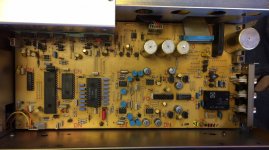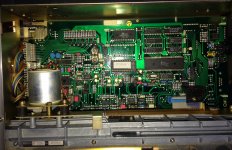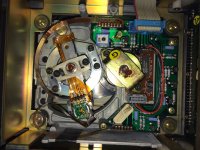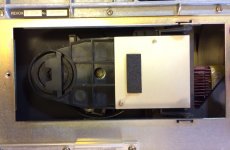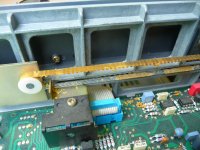I have a Revox B226 with issues. It powers up, the tray operates smoothly and the CD starts to load. The spindles starts up and spins for a few seconds, no track info displays and then the spindle stops. I have read a few threads here and started to pursue some of the suggestions. So far I have downloaded the service manual and schematics and cleaned/inspected the inside of the unit.
I plan to clean the laser, check the adjustment of the torx screw under the motor and check the condition of the electrolytic caps. I started by trying to inspect the 5 electrolytics that are supposed to be on the drive board under the unit. I found that my drive board does not have 5 EL caps and the board says Studer instead of Revox. I have included some pictures. Can someone tell me which transport I have and if this unit has been previously repaired or did they commonly mix circuit boards between Revox and Studer markings? Also, how do you suggest that I proceed? I have a scope and good electronics knowledge but this is my first CD player repair.
Thanks,
George
I plan to clean the laser, check the adjustment of the torx screw under the motor and check the condition of the electrolytic caps. I started by trying to inspect the 5 electrolytics that are supposed to be on the drive board under the unit. I found that my drive board does not have 5 EL caps and the board says Studer instead of Revox. I have included some pictures. Can someone tell me which transport I have and if this unit has been previously repaired or did they commonly mix circuit boards between Revox and Studer markings? Also, how do you suggest that I proceed? I have a scope and good electronics knowledge but this is my first CD player repair.
Thanks,
George
Attachments
I have a Revox B226 with issues. It powers up, the tray operates smoothly and the CD starts to load. The spindles starts up and spins for a few seconds, no track info displays and then the spindle stops. I have read a few threads here and started to pursue some of the suggestions. So far I have downloaded the service manual and schematics and cleaned/inspected the inside of the unit.
I plan to clean the laser, check the adjustment of the torx screw under the motor and check the condition of the electrolytic caps. I started by trying to inspect the 5 electrolytics that are supposed to be on the drive board under the unit. I found that my drive board does not have 5 EL caps and the board says Studer instead of Revox. I have included some pictures. Can someone tell me which transport I have and if this unit has been previously repaired or did they commonly mix circuit boards between Revox and Studer markings? Also, how do you suggest that I proceed? I have a scope and good electronics knowledge but this is my first CD player repair.
Thanks,
George
Find the laser output measuring point in the service schematics. Most manufacturers call that something like TP01 (tracking point 01). Hook up your oscilloscope and as soon as the player starts reading the disc, you should see a sine-pattern with an amplitude of around 1.5 Vtt. This gives you quite some insight:
1. the laser is putting out light and reading it
2. the focusing circuit is working
3. if the amplitude is smaller or unstable it means the laser is on it's way out
4. if the sine-pattern isn't locking, the tracking circuit isn't functioning
If Revox is anything like Philips (these are basically Philips players), they'll give you a troubleshooting diagram in the service manual
Good luck.
Do I use a test CD of some sort or just play generic music for the laser adjustments?
Thanks,
George
Thanks,
George
Hi Tjrep,
TP01 would be Test Point 01.
Hi George,
First off, never adjust anything in a CD player you are troubleshooting! Especially not mechanical adjustments. The unit worked earlier with those adjustments, so they are therefore very close at the worst case. Mechanical adjustments are typically a nightmare to correct in a Philips, and in a Studer or Revox that isn't working, you can't use the adjustment procedure - so you would be digging yourself in to a hole.
The alignment jig for tracking gain is different between Studer/Revox and Philips. The test discs used are the same. Philips 5 and 5A. You need a laser power meter and a good DVM to determine if the laser has passed its useful life (you really do). For the test Tjrep suggested, any good CD will do.
I was an authorized warranty technician for Revox when those machines were current. Also, check the flat cable that runs along the left side of the loader for cracks or splits. If it is split or cracked, replace the flat cable before it blows the laser diode. I might have the model wrong on the flat cable thing, but if there is a flat cable on the left side, check it as this is one failure mode.
-Chris
Other than that, they are good machines.
TP01 would be Test Point 01.
Hi George,
First off, never adjust anything in a CD player you are troubleshooting! Especially not mechanical adjustments. The unit worked earlier with those adjustments, so they are therefore very close at the worst case. Mechanical adjustments are typically a nightmare to correct in a Philips, and in a Studer or Revox that isn't working, you can't use the adjustment procedure - so you would be digging yourself in to a hole.
The alignment jig for tracking gain is different between Studer/Revox and Philips. The test discs used are the same. Philips 5 and 5A. You need a laser power meter and a good DVM to determine if the laser has passed its useful life (you really do). For the test Tjrep suggested, any good CD will do.
I was an authorized warranty technician for Revox when those machines were current. Also, check the flat cable that runs along the left side of the loader for cracks or splits. If it is split or cracked, replace the flat cable before it blows the laser diode. I might have the model wrong on the flat cable thing, but if there is a flat cable on the left side, check it as this is one failure mode.
-Chris
Other than that, they are good machines.
Do I use a test CD of some sort or just play generic music for the laser adjustments?
Thanks,
George
Hi George,
A special test cd would be preferable as it has a pre-set return value due to an optimized reflection layer, but normally any decent quality generic CD will do as long as it isn't scratched to h*** and back.
Tjeerd
Hi Tjrep,
TP01 would be Test Point 01.
Hi George,
First off, never adjust anything in a CD player you are troubleshooting! Especially not mechanical adjustments. The unit worked earlier with those adjustments, so they are therefore very close at the worst case. Mechanical adjustments are typically a nightmare to correct in a Philips, and in a Studer or Revox that isn't working, you can't use the adjustment procedure - so you would be digging yourself in to a hole.
The alignment jig for tracking gain is different between Studer/Revox and Philips. The test discs used are the same. Philips 5 and 5A. You need a laser power meter and a good DVM to determine if the laser has passed its useful life (you really do). For the test Tjrep suggested, any good CD will do.
I was an authorized warranty technician for Revox when those machines were current. Also, check the flat cable that runs along the left side of the loader for cracks or splits. If it is split or cracked, replace the flat cable before it blows the laser diode. I might have the model wrong on the flat cable thing, but if there is a flat cable on the left side, check it as this is one failure mode.
-Chris
Other than that, they are good machines.
Chris,
You're right, I knew from memory it was TP01 but as it has been decades since I last adjusted a CD-player, I came up with tracking point instead of test point. I don't know why, it could be that some manufacturers called it tracking point, in any case it just popped up.
Tjeerd
Do you know any competent repair techs in the US that are familiar with my Revox model?
Thanks,
George
Thanks,
George
Hi George
There has got to be someone near you. These techs kept pretty much to themselves, but the tape machine techs were well known. Maybe one of those fellas can point you in the right direction. I'm talking about Studer recording studio technicians. They should know who in their area did the CD and cassette product (Revox home products).
A good technician will have a long turnaround time - 'cause they will be busy.
-Chris
There has got to be someone near you. These techs kept pretty much to themselves, but the tape machine techs were well known. Maybe one of those fellas can point you in the right direction. I'm talking about Studer recording studio technicians. They should know who in their area did the CD and cassette product (Revox home products).
A good technician will have a long turnaround time - 'cause they will be busy.
-Chris
Yours is later production B226 with Philips CDM-1 transport and SAA7210 instead of 8404 decoder found in earlier production units. All Revox PCBs were branded Studer.
If the disc spins upon insertion, that means the RAFOC unit is alive because it has detected a reflective surface but fails to read out TOC. On inserting a CD, you should see the laser pickup bobbing up and down.
I would replace two capacitors on CD drive board and check ripple on all regulated voltages because faulty capacitors in this CD player can cause symptoms like yours. Replace or check C4, C5, C11, C12 on Decoder PCB.
If the disc spins upon insertion, that means the RAFOC unit is alive because it has detected a reflective surface but fails to read out TOC. On inserting a CD, you should see the laser pickup bobbing up and down.
I would replace two capacitors on CD drive board and check ripple on all regulated voltages because faulty capacitors in this CD player can cause symptoms like yours. Replace or check C4, C5, C11, C12 on Decoder PCB.
Yours is later production B226 with Philips CDM-1 transport and SAA7210 instead of 8404 decoder found in earlier production units. All Revox PCBs were branded Studer.
If the disc spins upon insertion, that means the RAFOC unit is alive because it has detected a reflective surface but fails to read out TOC. On inserting a CD, you should see the laser pickup bobbing up and down.
I would replace two capacitors on CD drive board and check ripple on all regulated voltages because faulty capacitors in this CD player can cause symptoms like yours. Replace or check C4, C5, C11, C12 on Decoder PCB.
Thanks, I’ll look at the caps and laser.
George
disk start. maybe 2 sec rotate to one side, 1 second to another and stop. of cos, no TOC and not reading. where live dewil? b225s. strange, tda1541aR1, not S crown...
Check the spindle bearing
Copied from user mat02ah:
"The CDM1 has a plastic screw (which is actually part of the motor bearing) to adjust the height of the spindle. If this bearing is worn out, the CD will be too close to the optical pick up. This will cause problems with the focus."
Have a look here:
Philips CDM-1 and CD-R, CD-RW
Here are some pictures and how to fix it:
https://www.technikundnatur.eu/revox-mehr/das-cdm-1-laufwerk.html
My B226 had the same issue. Measure the height of the CD platter before removing the bearing, this gives you a starting point for the adjustment.
Copied from user mat02ah:
"The CDM1 has a plastic screw (which is actually part of the motor bearing) to adjust the height of the spindle. If this bearing is worn out, the CD will be too close to the optical pick up. This will cause problems with the focus."
Have a look here:
Philips CDM-1 and CD-R, CD-RW
Here are some pictures and how to fix it:
https://www.technikundnatur.eu/revox-mehr/das-cdm-1-laufwerk.html
My B226 had the same issue. Measure the height of the CD platter before removing the bearing, this gives you a starting point for the adjustment.
- Home
- Source & Line
- Digital Source
- Revox B226 issues



